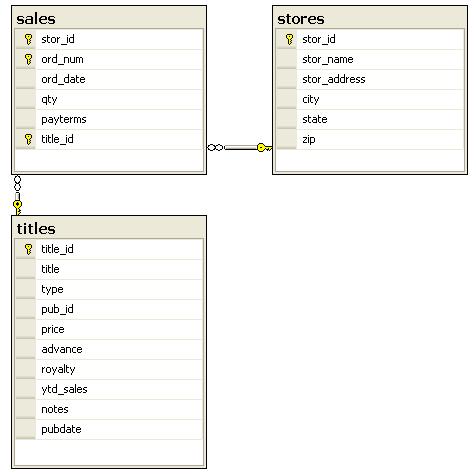补充:巧不巧,大家看下就知道了,如果觉得不巧,再拍砖也不迟,^_^
这是我进公司时SQL培训出的题.其中的pubs为SQLServer的示例数据库.(向SQLServer中添加pubs的代码见附件)
查看 stores,sales and titles 关联后的表
1 with temp as
with temp as
2 (
(
3 SELECT dbo.stores.stor_id,dbo.stores.stor_name,dbo.titles.type,dbo.sales.qty
SELECT dbo.stores.stor_id,dbo.stores.stor_name,dbo.titles.type,dbo.sales.qty
4 FROM dbo.sales
FROM dbo.sales
5 INNER JOIN dbo.stores
INNER JOIN dbo.stores
6 ON dbo.sales.stor_id=dbo.stores.stor_id
ON dbo.sales.stor_id=dbo.stores.stor_id
7 INNER JOIN dbo.titles
INNER JOIN dbo.titles
8 ON dbo.sales.title_id=dbo.titles.title_id
ON dbo.sales.title_id=dbo.titles.title_id
9 )
)
 with temp as
with temp as2
 (
(3
 SELECT dbo.stores.stor_id,dbo.stores.stor_name,dbo.titles.type,dbo.sales.qty
SELECT dbo.stores.stor_id,dbo.stores.stor_name,dbo.titles.type,dbo.sales.qty4
 FROM dbo.sales
FROM dbo.sales 5
 INNER JOIN dbo.stores
INNER JOIN dbo.stores6
 ON dbo.sales.stor_id=dbo.stores.stor_id
ON dbo.sales.stor_id=dbo.stores.stor_id7
 INNER JOIN dbo.titles
INNER JOIN dbo.titles8
 ON dbo.sales.title_id=dbo.titles.title_id
ON dbo.sales.title_id=dbo.titles.title_id9
 )
)//如果对temp进行查询,则结果为:

一、常规的思路:
利用子查询
1 select distinct stor_id,stor_name
select distinct stor_id,stor_name
2 from temp as t
from temp as t
3 where [type]= 'business' and exists
where [type]= 'business' and exists
4 (
(
5 select * from temp where stor_id = t.stor_id and [type] = 'mod_cook'
select * from temp where stor_id = t.stor_id and [type] = 'mod_cook'
6 )
)
 select distinct stor_id,stor_name
select distinct stor_id,stor_name2
 from temp as t
from temp as t3
 where [type]= 'business' and exists
where [type]= 'business' and exists4
 (
(5
 select * from temp where stor_id = t.stor_id and [type] = 'mod_cook'
select * from temp where stor_id = t.stor_id and [type] = 'mod_cook'6
 )
)
这种方法容易理解,但是执行效率低,会出现多次扫描表!我们来看第二种思路(我的解法)
二、利用PIVOT函数,来个行列转换:
把type的business与mod_cook列值转换成表的字段,就可以直接用where business is not null and mod_cook is not null 直接筛取了
详细过程:
1.转置
1 SELECT stor_id,stor_name ,[business],[mod_cook]
SELECT stor_id,stor_name ,[business],[mod_cook]
2 FROM temp AS S
FROM temp AS S
3 PIVOT
PIVOT
4 (
(
5 SUM(qty)
SUM(qty)
6 FOR [type] in([business],[mod_cook])
FOR [type] in([business],[mod_cook])
7 ) AS R
) AS R
8
9
 SELECT stor_id,stor_name ,[business],[mod_cook]
SELECT stor_id,stor_name ,[business],[mod_cook]2
 FROM temp AS S
FROM temp AS S3
 PIVOT
PIVOT4
 (
(5
 SUM(qty)
SUM(qty)6
 FOR [type] in([business],[mod_cook])
FOR [type] in([business],[mod_cook])7
 ) AS R
) AS R8

9

结果:

2.据条件筛:WHERE [business] IS NOT NULL AND [mod_cook] IS NOT NULL
结果:

应题目需要,修改后的代码完整如下:
1 SELECT stor_id,stor_name
SELECT stor_id,stor_name
2 FROM temp AS S
FROM temp AS S
3 PIVOT
PIVOT
4 (
(
5 SUM(qty)
SUM(qty)
6 FOR [type] in([business],[mod_cook])
FOR [type] in([business],[mod_cook])
7 ) AS R
) AS R
8 WHERE [business] IS NOT NULL AND [mod_cook] IS NOT NULL
WHERE [business] IS NOT NULL AND [mod_cook] IS NOT NULL
9
10
 SELECT stor_id,stor_name
SELECT stor_id,stor_name2
 FROM temp AS S
FROM temp AS S3
 PIVOT
PIVOT4
 (
(5
 SUM(qty)
SUM(qty)6
 FOR [type] in([business],[mod_cook])
FOR [type] in([business],[mod_cook])7
 ) AS R
) AS R8
 WHERE [business] IS NOT NULL AND [mod_cook] IS NOT NULL
WHERE [business] IS NOT NULL AND [mod_cook] IS NOT NULL9

10

最终结果:

这个种方法比较拗,但利用了PIVOT转置行列避免了多次扫描表,效率不错!
也是新手,如果有不对的或是不合理的地方大家多拍砖!
附:向数据库添加Pubs实例库的代码:https://files.cnblogs.com/FojamesChen/pubs.rar

